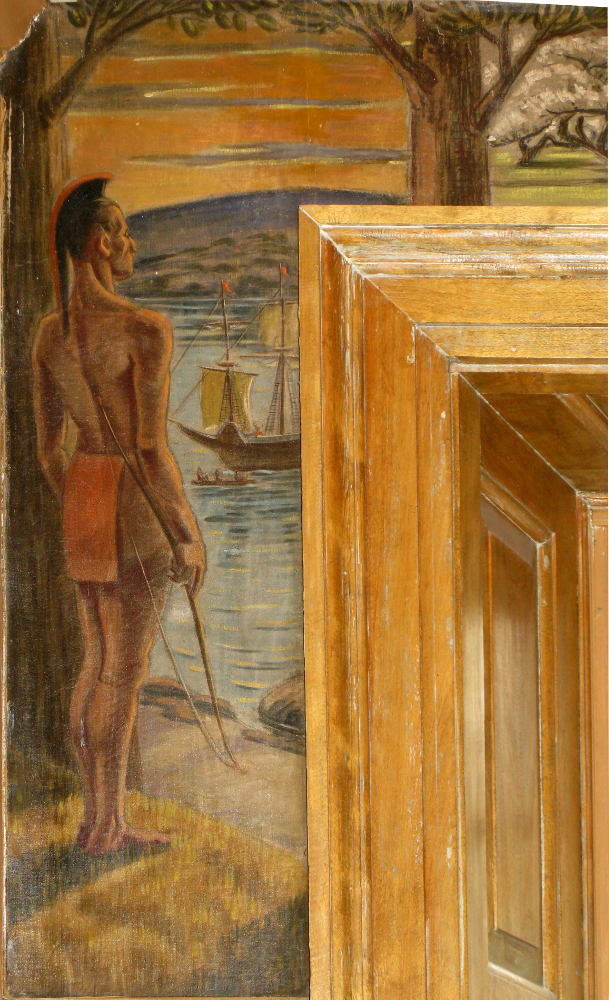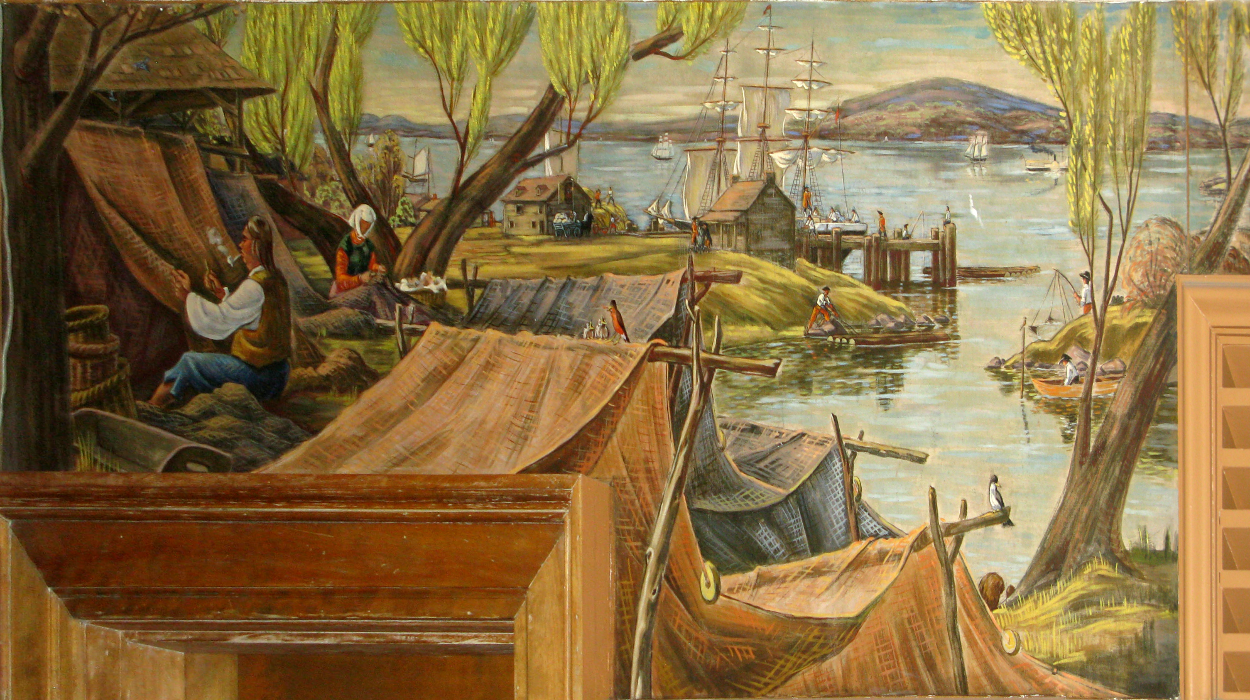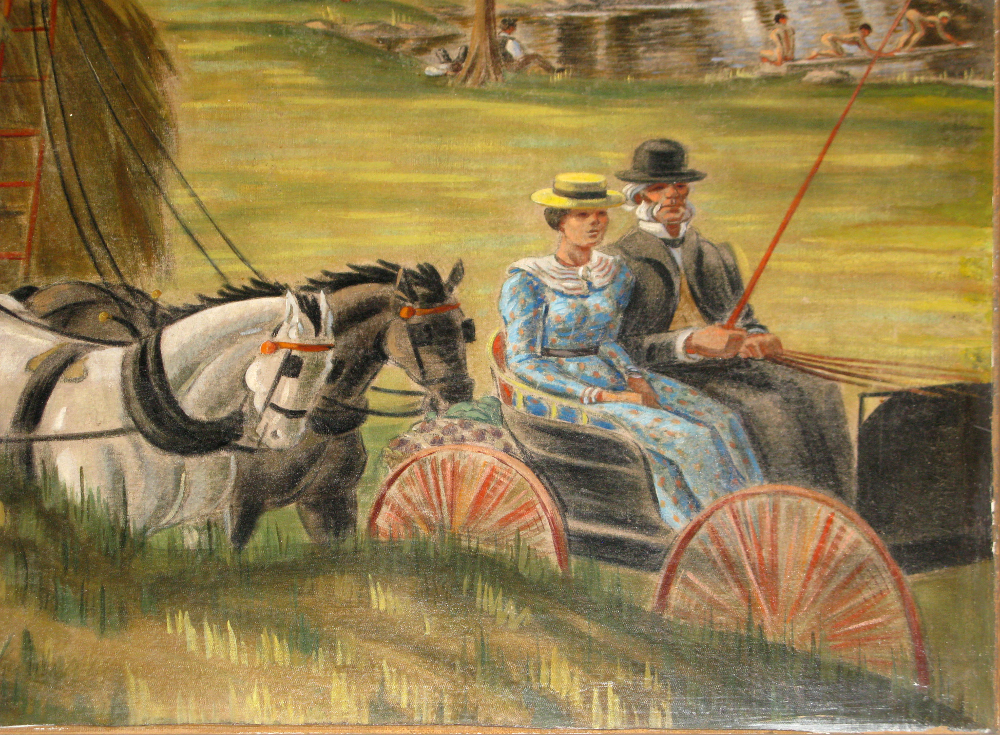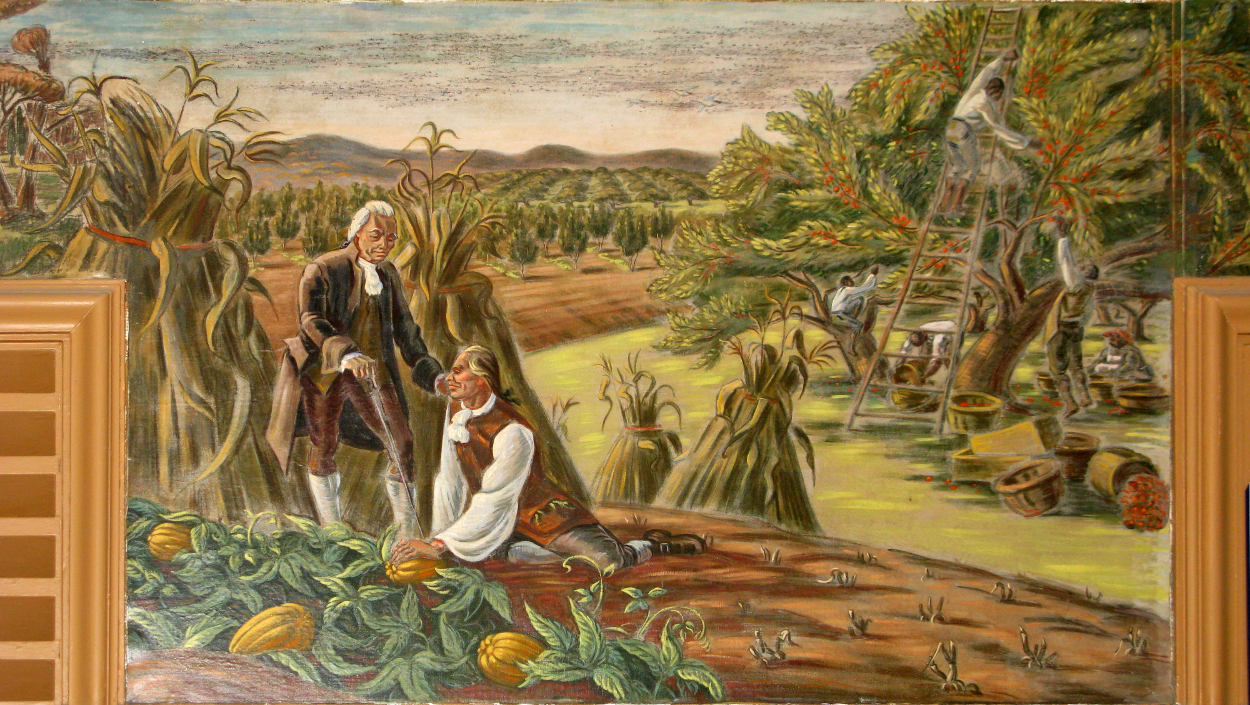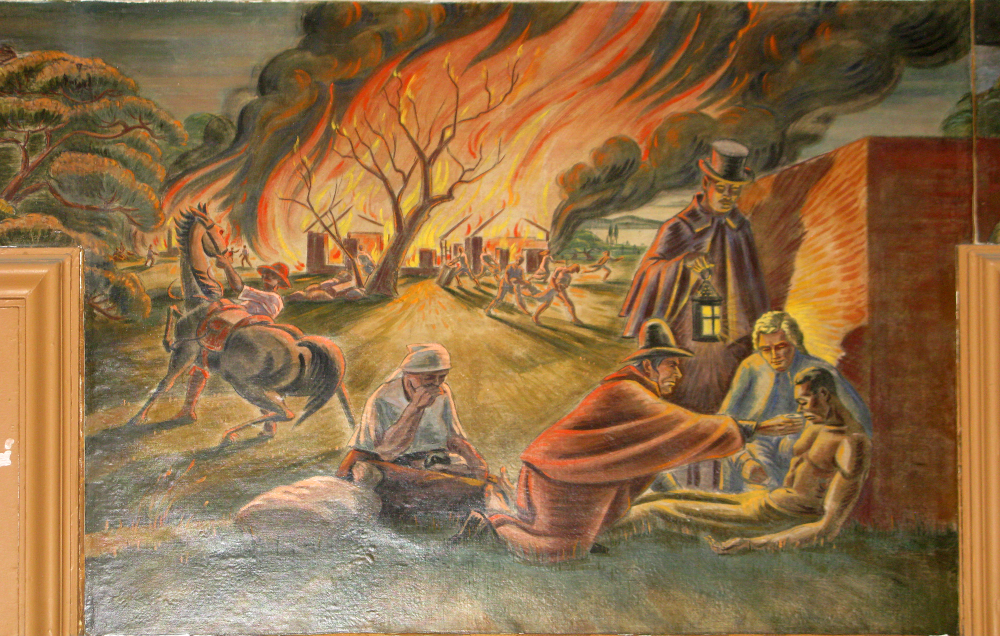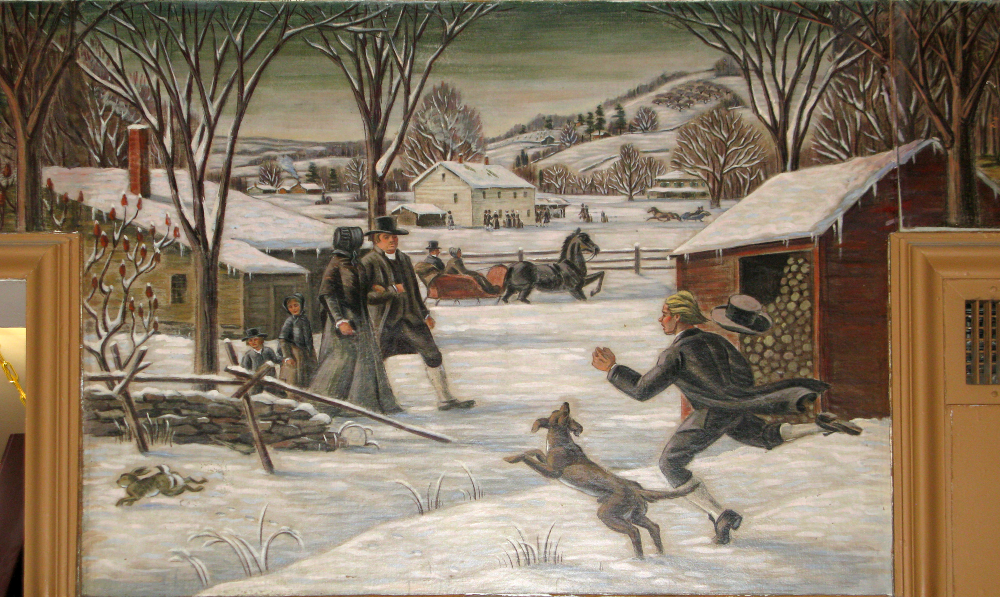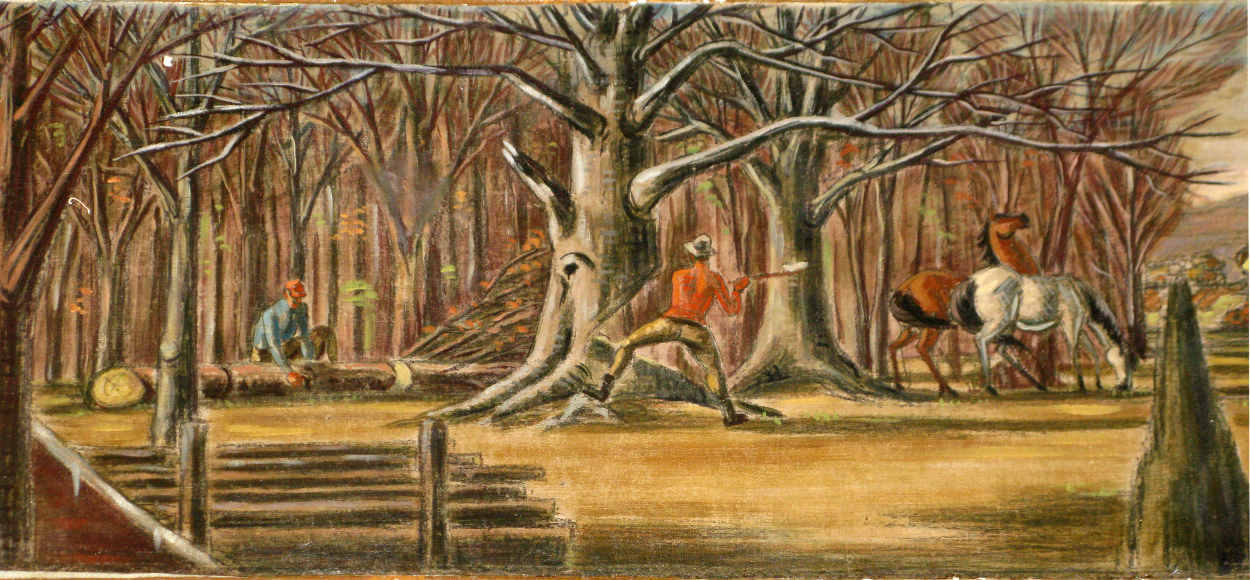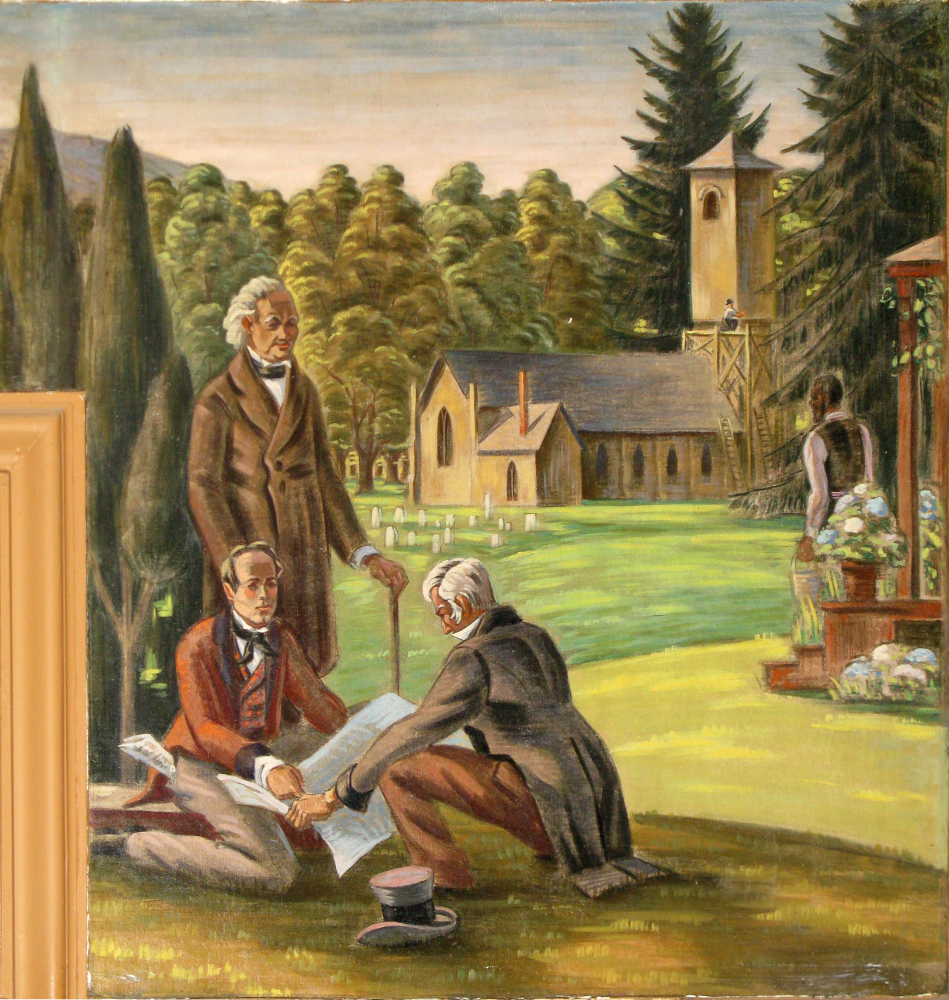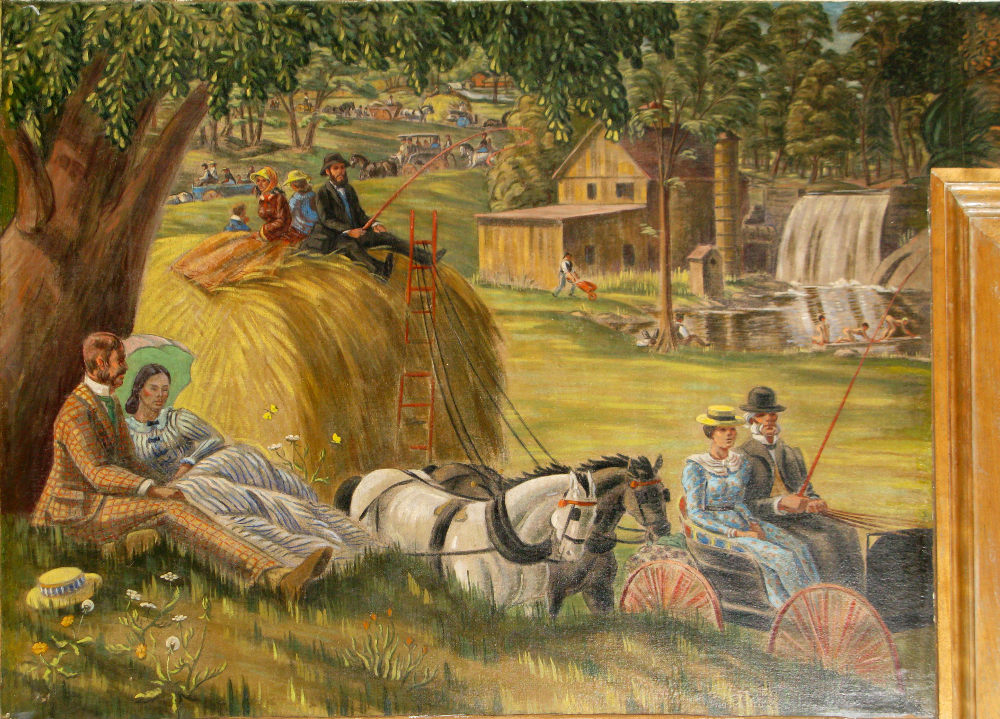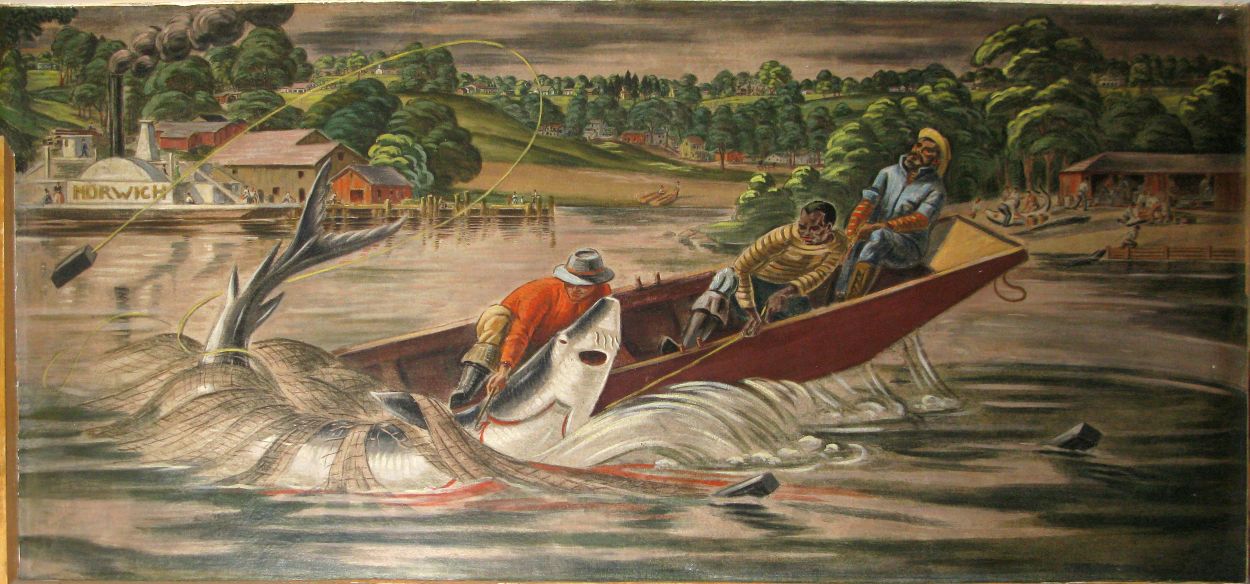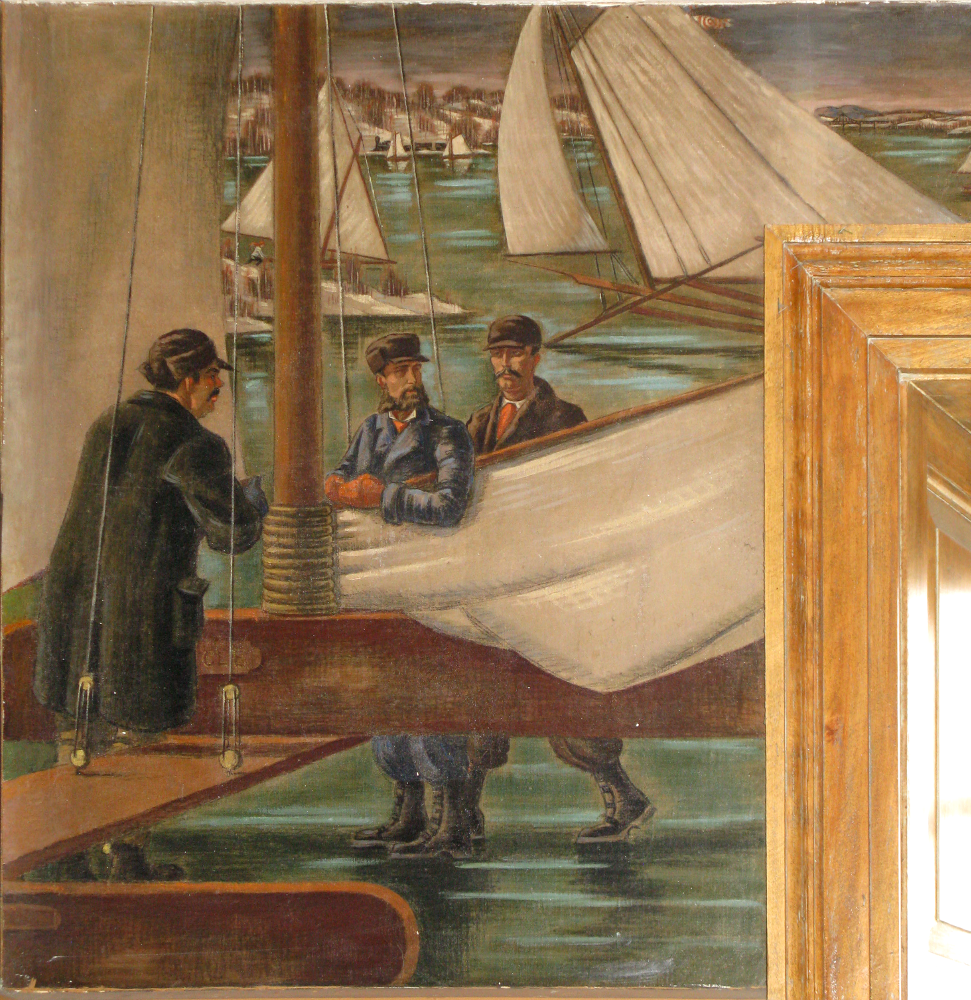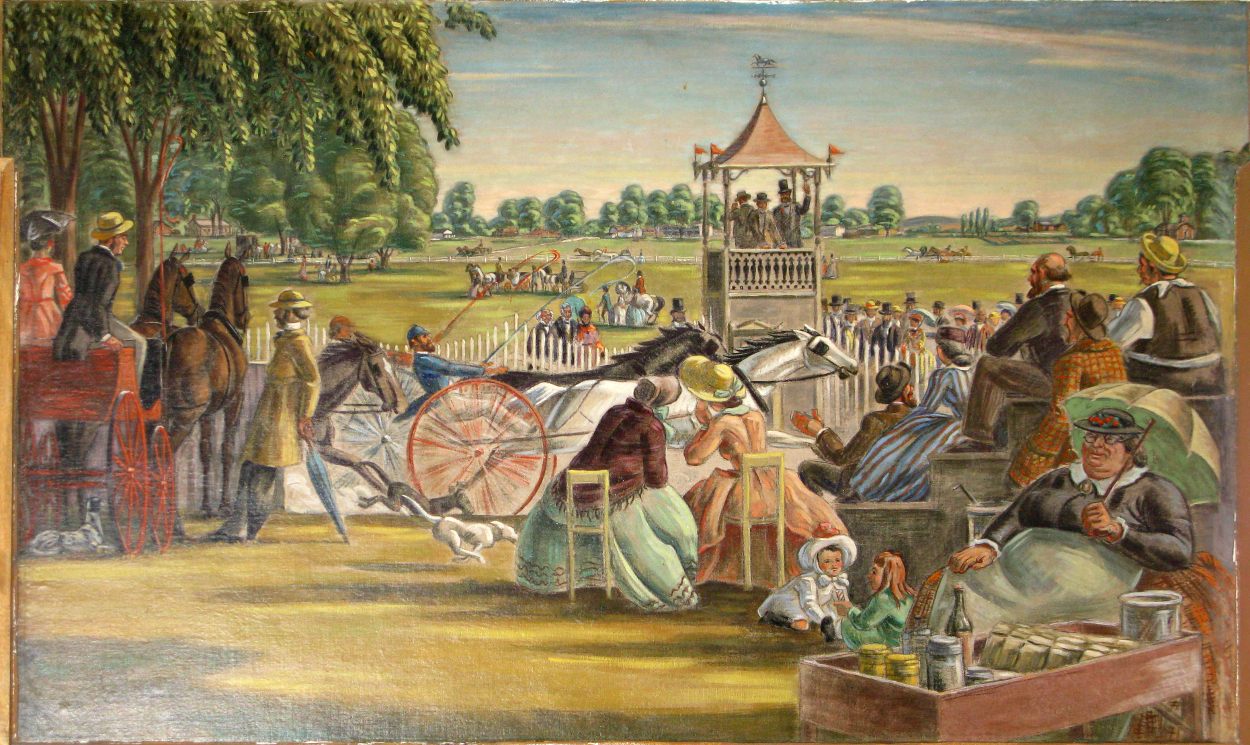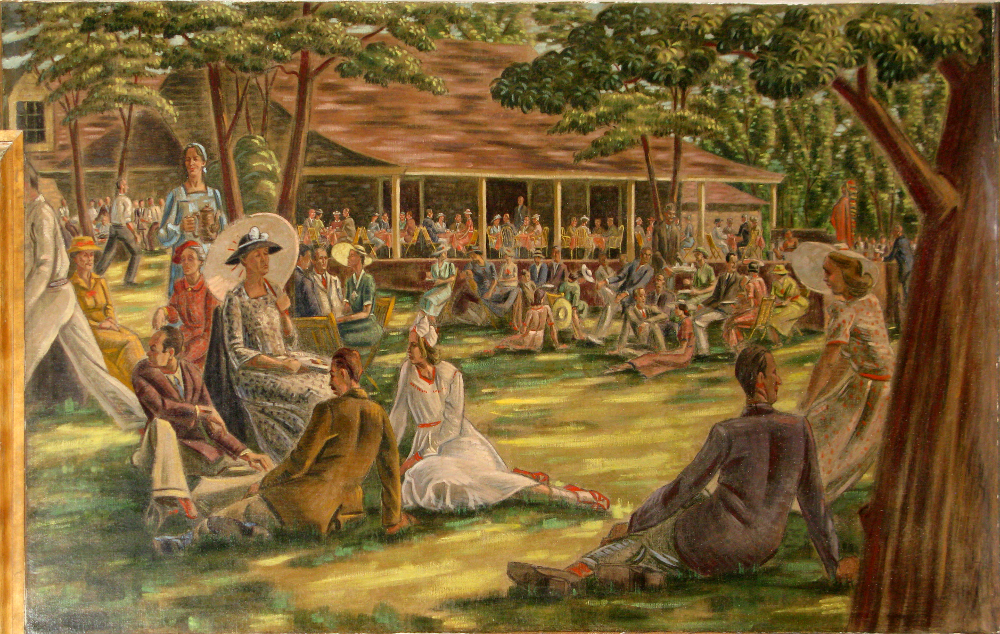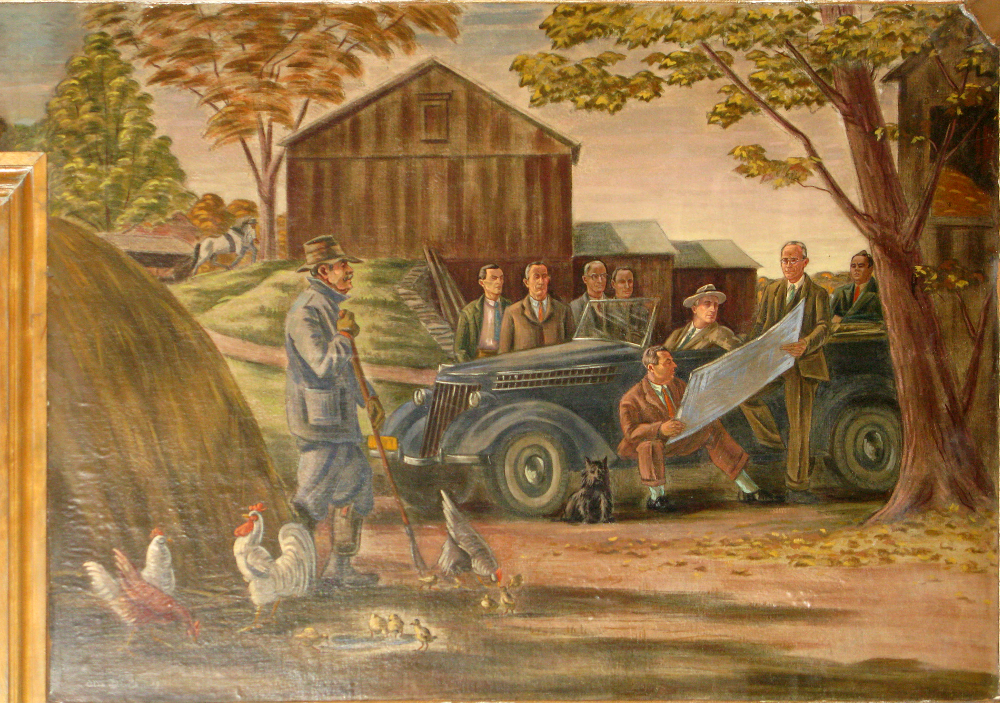Information
The Hyde Park Post Office has some of the best-preserved, most attractively-displayed and best-documented murals from the Depression Era. They were painted in 1941 by Olin Dows at the express invitation of Franklin Delano Roosevelt, following Dows work at the Rhinebeck, New York Post Office.
There are 19 panels, numbered below from left to right as one enters the front door of the post office. The artist himself provided very informative descriptions of the murals, which have been compiled on the Web site of the Hudson River Valley Institute, compliments of the Roosevelt-Vanderbilt Historical Association. These are quoted below:
PANEL 2: Before 1812. Irate Dr. Samuel Bard tries vainly to persuade Innkeeper Jabez Miller to change the name on his signboard, from "Hyde Park" to almost anything else, "Hyde Park" being the name of the Doctors country place. In 1812 Miller succeeded in having the Post Office called Hyde Park. The row of cherry trees leads over the hill to Jacobus Stoutenburgh's second stone house.
MURAL: 5441 PHOTO: 5444
PANEL 3: Before 1741. Jacobus Stoutenburgh, his sons and slaves clear the land. His log cabin, built in 1723, was the first house in Hyde Park Village — the Kings Highway, then a grassy "wagon" road, passed in front — Jacobus and his wife Margaret Teller had eight children who varied in age, in 1741, from 23-year-old Tobias to 5-year-old Luke.
MURAL: 5441 PHOTO: 5456
PANEL 4: About 1795. Richard De Cantillon, Tobias Stoutenburghs son-in-law, supervises workmen unloading rum, sugar, and molasses from one of his West India trading packets. His landing, site of the present station, was a most active and prosperous enterprise. A man and a woman mend shad nets — logs are poled to shore for the mill — a hay boat is loaded.
MURAL: 5441 PHOTO: 5446
PANEL 5: July 24, 1835. Dr. David Hosack and Miss Harriet Martineau drive a gig past Bard's Rock where the crew of a whaler rolls casks of spring water to their ship. Dr. Samuel Bard's store and two dwellings face the river. Hosack (medical partner of Samuel Bard and Professor of Natural History at Columbia College) bought this place from William Bard in 1823 and between then and 1830 Andre Paramentier, a Belgian, said to be the first landscape gardener in the country, redesigned the property for him. It is the present Vanderbilt place.
MURAL: 5441 PHOTO: 5458
PANEL 6: In the late 1780's. Dr. John Bard and Dr. Samuel Bard examine their new Italian melons, fertilized with gypsum. The latter's pockets bulge as usual with plants — a flock of wild pigeons fly across the sky. These two men were New York's most distinguished physicians — Dr. John, a friend of Benjamin Franklin and a member of his Club, was the first President of the New York Medical Society; with Dr. Peter Middleton performed the first dissection for instruction, and the first diagnosis and successful operation for extra uterine pregnancy recorded in the colonies. As what was virtually public health officer, he fought yellow fever and recommended the purchase of Bedloe's Island as a quarantine station. Dr. Samuel, who studied in Edinborough, was on his return instrumental in founding the medical school of King's College, later the College of Physicians and Surgeons, was its first Professor of medicine and President. He also was the first to agitate for a hospital. He encouraged the local use of clover as a crop as well as other horticultural improvements and was first President of the Society of Dutchess County for the Promotion of Agriculture (1806). Although Loyalists, the Bards were highly respected by both sides, Dr. Samuel taking care of President Washington in 1789 with Dr. John as consultant.
MURAL: 5441 PHOTO: 5445
PANEL 8: 1810 — Dr. Samuel Bard gives first aid to a negro who has been burnt, while his son William holds the lantern and his son-in-law John McVickar supports the wounded man. McVickar was rector of St. James Church, the first professor of Political Philosophy (Economics) at King's College (Columbia), and author of an interesting biography of his father-in-law.
MURAL: 5441 PHOTO: 5450
PANEL 12: 1846 — The Reverend Reuben Sherwood and two vestrymen, Archibald Rogers (grandfather of the Colonel in the last panel) and Augustus Cowman discuss plans for the St. James Church. Cowman (publisher of two papers in Poughkeepsie) went abroad to study church architecture in England and designed, supervised the building, and materially assisted in the financing of this church on his return. Sexton Richard Jenkins leaves the Rectory porch with a pot of Downing's tastefully toned buff paint.
MURAL: 5441 PHOTO: 5434
PANEL 15: 1870 — William Meier (head of Hyde Park's caviar industry) pulls up an oversized sturgeon helped by Abe Atkins (drowned later when the Mary Powell capsized his boat). Fish are being disemboweled on the beach and caviar being made in the shed. The Norwich (1823) docks on her way to New York (The layout of this dock comes from a survey made in 1845 by George Van Vliet.) — On the hill the houses from left to right: Langdon House (originally built by Samuel Bard about 1800. Torn down by Frederick Vanderbilt 1895) and water wheel — Jacobus Stoutenburgh's second stone house (before 1768) — the first hotel — the first store — Church of the Stoutenburgh Religious Society (1789) flanked by the colored and white schools. Later buildings: The Hotel (burned 1879) — Horning House — Fire House Tower (1902) — Town Hall (1891) — James Roosevelt Memorial Library (1926) — Methodist Church (1834) — Former Baptist Church (1846) — St. James Rectory (after 1836) — Regina Coeli Church (1863) — Stone House (before 1780) — Crumwold Hall (1889, architect Richard Morris Hunt) — Stone House (before 1776) — Gerald Morgan House (about 1812, remodeled by McKim, Meade & White, 1911) — Mrs. James Roosevelt (1826, added between 1845-67, remodeled by Francis L. V. Hoppin) — Mrs. J.R. Roosevelt (1804).
MURAL: 5441 PHOTO: 5432
PANEL 16: 1886 — Jacob Buckhout discussed the "Icicle" with its owner John Roosevelt while Archibald Rogers joins them. In the middle ground the latine rigged "Hawk" built for Franklin D. Roosevelt by George Buckhout is just starting out — while the Rogers' "Jack Frost" takes a hard tack on one runner. In the left background the "Icicle" and the "Jack Frost" have just beaten the New York Central Express on a two mile course. In the right background and over the window is the "Bessie" built by Samuel Rogers (1897) and a group of modern ice boats — one, the "Arrow" owned by the present Commodore of the Hudson River Ice Boat Club Kunze Todd. The Poughkeepsie Bridge (built 1888) and the Mid-Hudson Bridge (dedicated in 1930 by Governor Roosevelt) can be seen in the distance.
MURAL: 5441 PHOTO: 5438
PANEL 17: 1850 — The Union Corners Race Track — James Roosevelt in his breaking cart calls to a friend — Daniel Whigg, in blue coat, trots by watched from the pother side of the fence by Martin Van Buren and James K. Paulding (his former Secretary of the Navy and popular novelist) — while the owner of the track, John Albert Stoutenburgh, rings the bell in the judges stand. The peanut wagon in the foreground contains yellow cans and a bottle of Daniel Whigg's "Whirlbone Linament" equally good for man and beast. In the background, the William Stoutenburgh house (1750) the Union Corners Hotel (1820) and the old Red School House.
MURAL: 5441 PHOTO: 5439
PANEL 18: June 11, 1939 — Picnic at the President's Cottage for the King and Queen of England who are at the two center tables under the porch with the President — Mrs. James Roosevelt — Secretary of the Treasury and Mrs. Henry Morgenthau, Jr. and Governor and Mrs. Herbert Lehman.
MURAL: 5441 PHOTO: 5440
PANEL 19: 1939 — The President and the Hyde Park School Board discuss plans for the Roosevelt High School in Benjamin Haviland's yard. From left to right: Benjamin Haviland, who sold his land on which the school now stands — Raymond Hill — and Samuel Matthews — Frank E. Botsford — the late Arthur E. J. White — Alexander Horton — The President — Ralph R. Smith and Thomas Qualters (bodyguard). Fala, the President's Scottie, watches chickens.
MURAL: 5441 PHOTO: 5441
